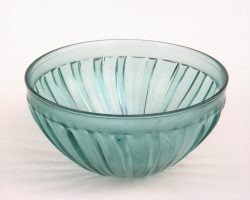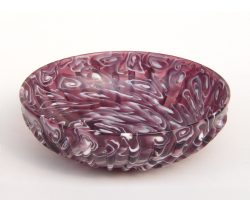

This article appeared in Current Archaeology 186 (June - July 2003) as part of a series of articles devoted to glass in advance of the AIHV 2003 Congress in London. This is the original form of the article.
Discovering the techniques employed in making ancient glass is a challenge that has occupied us for twelve years. We have devoted most of this time to free-blown and mould-blown Roman glass vessels.
Over the last two years we have concentrated on reproducing Hellenistic and Roman mosaic glass bowls, developing techniques which are likely to have been used by ancient glassmakers. In the past there have been several suggestions as to how these polychrome vessels were made, including the belief that they were formed by arranging sections of patterned canes in moulds and firing them in a kiln. However, our work has led us to the conclusion that all ancient mosaic glass bowls (and other open forms) were made 'live' at the furnace mouth by fusing pre-formed cane sections to form a flat glass disc, which was then slumped over a form. This method allows vital tooling work to be performed on the disc whilst it is fusing, controlling shape, size and pattern, as well as the addition of a footring where necessary. Final grinding and polishing is achieved by mounting the bowl on a powered wheel so that it can be worked from above, rather than from the side, as would occur if the vessel were mounted on a lathe.
A natural progression of this technique led us to address the problem of ribbed ('pillar-moulded') bowl manufacture. Again, different theories regarding the rib-forming process have been advanced over the years; some have suggested that they were made by stamping a disc of molten glass using a mould with radial grooves, whilst others believe that ribs were raised by pressing a metal bar at intervals against a hot glass bowl whilst still on its form.

The vast numbers of recorded finds of ribbed bowl fragments attest to their popularity over a date range of least one hundred and fifty years until the late first century AD. This suggests an uncomplicated method of manufacture which accords with other glassworking techniques of the period.

We believe that the ribs were formed by using a pair of pincers, pinching one rib at a time from a flat disc of molten glass. With practise, seven or eight ribs can be formed before the disc needs re-heating, and when complete, the disc is slumped over a form as for mosaic glass. Rib-pinching has been suggested in the past*, but we have recently been developing this process to the point where it is a viable, easily repeatable and, above all, relatively fast method of production, and one which reproduces all of the characteristics of ancient ribbed bowls (see photographs). The area immediately above the tops of the ribs contains tool marks (produced by the bowl-formation process) which must be ground away using a rotating grinding wheel, after which the bowls are polished in the same way as the related mosaic glass vessels.
Only by practise over a long period of time are we able to discover the finer points and develop the skills necessary to succesfully reproduce ancient glass. We are still developing the techniques involved in making ribbed bowls and, as we so often find, ancient glassmakers used the simplest techniques they could.
Mark Taylor and David Hill 2003